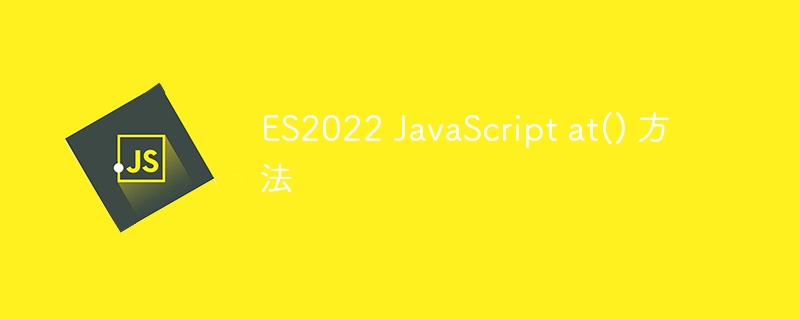

JavaScript is a powerful and versatile programming language that is widely used for both front-end and back-end development. One of the things that makes JavaScript so powerful is its extensive standard library, which includes many built-in methods for working with strings, arrays, and other data types. One such method is the at() method, introduced in ECMAScript 2022, which retrieves the character at a given index in a string. In this tutorial, we'll learn how to use the at() method and explore some of its advantages over the older charAt() method.
at() method is a string method that can be used to retrieve the character at a given index in a string. The syntax of this method is as follows -
string.at(index)
Where string is the string from which characters are to be retrieved, and index is the zero-based index of the character to be retrieved. This method returns the character at the specified index, or undefined if the index is out of range.
Here is an example of how to use the at() method to retrieve the first character of a string -
<html>
<body>
<p id="ES2022"></p>
<script>
let greeting = "Hello, world!";
let firstChar = greeting.at(0);
document.getElementById("ES2022").innerHTML = firstChar;
</script>
</body>
</html>
In this example, the at() method is used to retrieve the first character of the string greeting, which is "H". The result is then assigned to the variable firstChar and printed to the console.
The at() method has some advantages over the old charAt() method, which has been available in JavaScript since the beginning. For example, the at() method can handle out-of-bounds indexes in a more elegant way. When the charAt() method is called with an out-of-range index, it returns an empty string (""). In contrast, the at() method returns undefined when called with an out-of-bounds index. This allows you to more easily distinguish between empty strings and missing characters.
Another advantage of theat() method is that it handles Unicode characters correctly. In JavaScript, strings are stored as sequences of UTF-16 code units. This can cause problems when using Unicode characters that are represented by multiple code units, such as emojis or characters in some scripts. When called on such characters, the charAt() method may return incorrect results, while the at() method returns the correct character.
The following is an example of how the at() method handles out-of-range indexes,
<html>
<body>
<p id="ES2022"></p>
<script>
let greeting = "Hello, world!";
let character = greeting.at(20);
document.getElementById("ES2022").innerHTML = character;
</script>
</body>
</html>
In this example, the at(20) index is outside the string length range and the method returns undefined.
The at() method can also be used with a negative index, which counts from the end of the string instead of the beginning. This can be useful in cases where you want to retrieve the last character of a string, for example −
<!DOCTYPE html>
<html>
<body>
<p id="ES2022"></p>
<script>
let greeting = "Hello, world!";
let lastChar = greeting.at(-1);
document.getElementById("ES2022").innerHTML = lastChar;
</script>
</body>
</html>
In this example, the at(-1) method is used to retrieve the last character of the string greeting, which is "!". The result is then assigned to the variable lastChar and printed to the console.
at() method works seamlessly with other JavaScript functions that accept index parameters, such as Array.prototype.slice and String.prototype.substring. This allows developers to work with strings in a consistent way, whether they are using the at() method or one of the other string methods.
In summary, the at() method is a powerful and versatile method that provides a more reliable way to retrieve characters from JavaScript strings. It has significant advantages over the old charAt() method by correctly handling out-of-bounds indexes and Unicode characters. If you are developing a new JavaScript project, it is recommended to use the at() method instead of charAt() for more robust and consistent behavior.
It is worth noting that it is supported in modern browsers, so it is recommended to check the target browser support before using it in production. Additionally, you can use tools like Babel to convert your code to older versions of JavaScript if needed. With the at() method, JavaScript developers have a new powerful tool for working with strings in a more efficient and consistent way.
The above is the detailed content of ES2022 JavaScript at() method. For more information, please follow other related articles on the PHP Chinese website!




